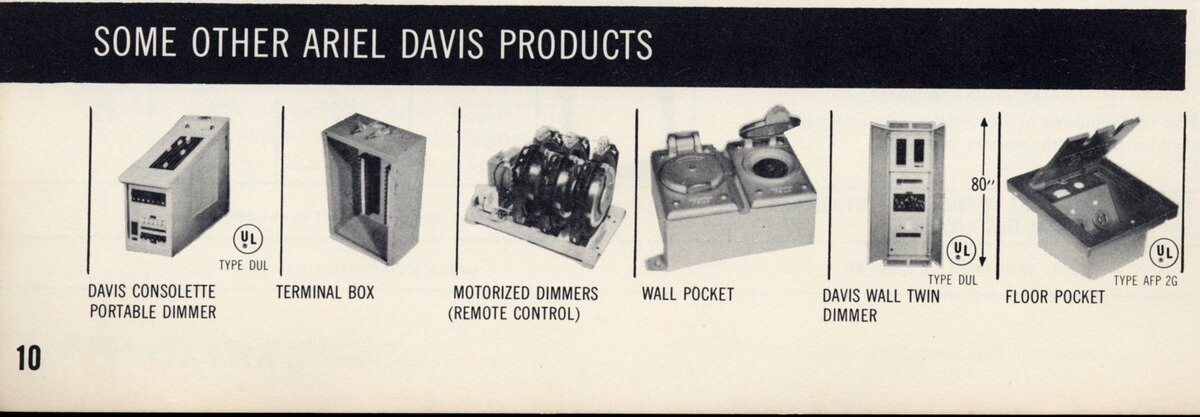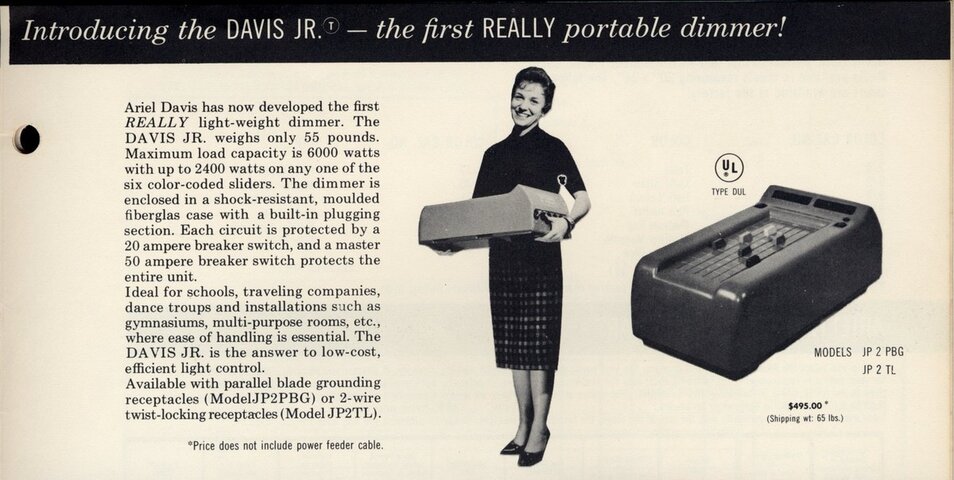NP> Can anyone tell me the manufacturer and model?
Because I am slow to respond to e-mail, I note that the
instrument has
already been
identified as one of Major's EXAL series ellipsoidals,
but I thought I'd muse a little about Major, Ariel Davis, Electro
Controls, and Major Control Devices on the outside chance that
somebody out there would enjoy the historical wanderings.
My lawyer insists I add that anything said here is my opinion and is
not intended as an accolade or perjorative to any person, business or
device....
The Major corporation was begun by Roscoe Major in the early 1900's.
The earliest
address I found for them was 4603 West Fullerton Avenue
in Chicago, but they moved to newer and better facilities out in
Crystal Lake Illinois in the mid 60's. When I was involved in their
equipment, Father Major's sons Frank and Ross ran the operation.
Interestingly, the bread and butter of their business was
manufacturing reflectors for traffic signal lights, which was a
natural extension of their capability to spin and hydroform aluminum
reflectors and apply the highly reflective
ALZAK coating found in
theatrical instruments.
The EXAL series of ellipsoidals and fresnels were so named because of
the body panels made of extruded aluminum, sporting an anodized rather
than painted surface. At the time, the design was quite advanced and,
as Mr. Price experienced, they enjoy (or suffer) a long life span.
Ariel Davis the man formed the
Ariel Davis Manufacturing company soon
after World War II, although I am at this writing too lazy to rummage
around in the back room to find early documentation. One of my
favorite stories about Ariel is that the design for his "Davis
Dimmer"
came to him in a dream one night! That
dimmer was a significant step
forward in that six slider taps could control six different 20 amp
circuits of light from one very large autotransformer coil inside the
unit. The units were very durable and we had two or three units in our
rental
stock for several years. Although Ariel was an imaginative and
capable engineer, he was not an effective businessman and his company
was sold to a management team that brought more profit out of the
organization. Originally, the new owners operated under "Ariel Davis
Manufacturing Company, exclusive distributors for
Electro Controls"
and later reversed the emphasis and ultimately dropped the references
to Ariel Davis although
Electro Controls continued to manufacture the
Davis
Dimmer and Ariel's innovative
patch panel called the
"Quick-Connect."
I sold
Electro Controls' equipment throughout the '70s and enjoyed the
experience, although I frequently felt like the "Hillbilly cousin" at
USITT,
NAB and ATA trade shows when I saw the considerably more
interesting and glitzier displays from other manufacturers in the
industry.
The
Parellipsphere was an attempt at an entirely new
luminaire,
intending to combine the desirable optical characteristics of
parabolic, ellipsoid and
spherical reflectors while minimizing the
inherent problems of each. To some the
instrument was similar to
the Studebaker automobiles, being simply ahead of their technology,
while to others it was a dreadful pariah. Because it was a popular art
form at the time, I created a string art wall hanging of the intricate
optical path of light rays inside the
Parellipshere but it was
abandoned
in one of the many subsequent relocations.
The Major Corporation dissolved in the late 1970's but some of the
engineers picked up some of the pieces to form Major Control Devices,
hoping to develop the expanding market for electronic dimmers. The
management team the operated
Electro Controls sold the theatrical
manufacturing operation to Major Control Devices in the early 1980's
and the entire mixture was subsequently purchased by
Strand a few
years later.

























